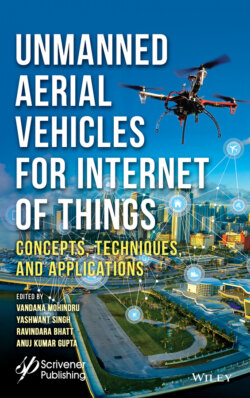Читать книгу Unmanned Aerial Vehicles for Internet of Things (IoT) - Группа авторов - Страница 53
2.2.1 Variations in Channel Characteristics
ОглавлениеThe control signaling and data signaling in UAV communication need two types of channels—UAV-ground and UAV–UAV channel. Both types of channels exhibit several unique characteristics.
a) Air to Ground Channel Modeling Due to complexity in the operating environments, systematic measurements and modeling of UAV-ground channels needs to be carried out as in Refs. [6, 7]. Problems to be considered are link blockage due to obstacles like terrain, buildings, shadowing during aircraft maneuvering in critical operations, multipath links due to reflections, scatterings, diffractions, from different physical contours like mountains, ground surface, foliage, water bodies, desert, etc.
Compared to the characteristics of terrestrial communication channels, the A2G channel characteristics differ in terms of coverage and capacity [8–12]. This demands for optimal designing and deployment of A2G channel models for various applications like cellular-connected UAV-UE and IoT communication. We need to consider the type of UAV, the altitude at which the UAV is placed, the angle of elevation between transmitter and receiver in the A2G link, type of propagation scenario (such as the rural scenario, suburban scenario, urban scenario, high rise urban scenario), the movements of the antennas at the UAVs, shadowing caused by the body of UAV, locations of ground users, etc. A probabilistic path loss model proposed by Hourani et al. [9, 13] has been widely adopted by researchers authoring the literature as in [14–24]. Table 2.1 lists the studies carried out till date for understanding the effect of various design parameters on the operation of A2G channel in UAV systems.
Deterministic models using environmental parameters and for studying large scale fading effects in A2G channels have been proposed in [27, 28]. The effect of propagation conditions on the coverage and optimal UAV positioning have been discussed in Refs. [29–33]. Geometric based stochastic models have been proposed for evaluating the spatial-temporal characteristics in a geometric simulation environment [34–39]. Further work needs to be carried out in the area of channel modeling of A2G links taking into consideration the communication over water bodies and communication in highly urban scenarios.
Table 2.1 Parameters determining the performance of A2G channel.
| Parameter worked upon | Reference |
| Effect of environment on path loss, delay spread, fading | [25] |
| Effect of high altitude of platform | [10, 11] |
| Effect on signal strength due to path loss and shadowing on account of various propagation scenarios and high elevation angle between transmitter and receiver. | [10] |
| Effect of low altitude UAV in suburban environments | [12] |
| Effect of angle of elevation and building height in urban environment | [26] |
b) Air to Air Channel Modeling A dominant LoS (Line of Sight) component is preferred for the air to air (A2A) communication channels of UAV communication. A2A propagation channel is useful in multi hop UAV networks for sensing and coordination applications. In case of emergency situations, it can replace the existing communication systems and provide a backhaul wireless connectivity. Large scale fading statistics in A2A propagation channels have been discussed in Refs. [40–45]. But the impact of antenna orientation, gain from UAV-MIMO system and Doppler spectrum of the A2A channel are yet to be worked upon. The major challenge encountered by these channels is the higher Doppler frequency shifts which occur due to higher relative velocity between UAVs. In 5G networks, if millimeter waves are used for backhauling than it would result in wider spectrum allocations, higher data rates, reduced latency in A2A channels. But the drawback is higher Doppler shifts. Hence we need to work out suitable techniques to be used in A2A links.
Various empirical and analytical channel models characterizing A2A and A2G propagation channels have been discussed in Ref. [46]. Multidimensional UAV channel modeling is yet to be explored thoroughly.
